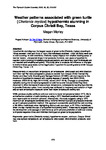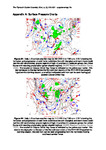Weather patterns associated with green turtle (Chelonia mydas) hypothermic stunning in Corpus Christi Bay, Texas
| dc.contributor.author | Morley, M. | |
| dc.date.accessioned | 2022-12-23T19:34:57Z | |
| dc.date.available | 2022-12-23T19:34:57Z | |
| dc.date.issued | 2022 | |
| dc.identifier.citation |
Morley, M. (2022) 'Weather patterns associated with green turtle (Chelonia mydas) hypothermic stunning in Corpus Christi Bay, Texas', The Plymouth Student Scientist, 15(2), pp. 275-297. | en_US |
| dc.identifier.issn | 1754-2383 | |
| dc.identifier.uri | http://hdl.handle.net/10026.1/20114 | |
| dc.description.abstract |
Hypothermic stunning was the largest cause of green turtle (Chelonia mydas) stranding in Texas between 1998 and 2019; of the 9,256 individuals stranded, 7,956 (85.96%) were due to cold stunning. In cold conditions, Chelonia mydas migrate from shallow feeding areas to warmer waters. Unexpected drops in temperature, however, can cause a hypothermic reaction (cold stunning) immobilising large populations and becoming fatal if individuals are not rescued and rehabilitated quickly. This study aims to evaluate the influence of changes in environmental parameters to the magnitude of hypothermic stunning events within Corpus Christi Bay, Texas, U.S. Measurements of sea surface temperature, air temperature, wind speed and wind direction from Bob Hall Pier were compared to pressure records from Corpus Christi Central City Station and Sea Turtle Stranding and Salvage Network (STSSN) cold stun reports for the duration of hypothermic seasons with varying degrees of severity: low (2012-2013), moderate (2009-2010), high (2014-2015), severe (2017-2018). Changes to atmospheric variables during the formation/progression of cold fronts over Corpus Christi Bay were observed to drive decreases in sea surface temperature, subsequently causing hypothermia in juvenile Chelonia mydas. Event severity was attributed to frequency and duration of frigid sea surface temperature exposure rather than water temperature cooling rate. While previous studies attribute cold stun events to water temperatures below 10°C, this is an ineffective predictor of cold stunning as using a 10°C threshold predicted days of cold stun reports and not events in advance. Alternatively, this study suggests using a 10°C maximum air temperature combined with a 1020mb minimum surface air pressure threshold as an in advance prediction method. This approach successfully predicted the cold stunning of 86.49% of individuals when highlighting distinct cold stun days, or 97.72% of individuals when the day marked the start of a hypothermic stunning event. These results suggest using the development and passage of cold fronts as an in advance prediction of cold stun events to improve response times and minimise the impact on green turtle populations. | en_US |
| dc.language.iso | en | en_US |
| dc.publisher | University of Plymouth | en_US |
| dc.rights | Attribution 3.0 United States | * |
| dc.rights.uri | http://creativecommons.org/licenses/by/3.0/us/ | * |
| dc.subject | green turtle (Chelonia mydas) | en_US |
| dc.subject | hypothermic season | en_US |
| dc.subject | cold stun | en_US |
| dc.subject | Corpus Christi Bay | en_US |
| dc.subject | sea surface temperature | en_US |
| dc.subject | air temperature | en_US |
| dc.subject | wind speed | en_US |
| dc.subject | wind direction | en_US |
| dc.subject | pressure | en_US |
| dc.subject | cold front | en_US |
| dc.title | Weather patterns associated with green turtle (Chelonia mydas) hypothermic stunning in Corpus Christi Bay, Texas | en_US |
| dc.type | Article | en_US |
| plymouth.issue | 2 | |
| plymouth.volume | 15 |




